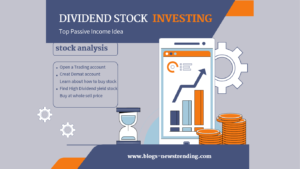- UNDERSTANDING DIVIDEND STOCKS
An essential component of investing for passive income is dividend stocks. It’s critical to comprehend what they are and how they differ from conventional stocks in order to fully appreciate their significance.

Dividend stocks are essentially ownership interests in businesses that pay dividends to their shareholders as a percentage of their earnings. Investors receive a consistent stream of income from these dividends, which are frequently distributed on a quarterly basis.
Purchasing dividend-paying stocks has a number of benefits. First of all, they offer a steady source of revenue. Dividends might be a stable source of cash flow if you’re wanting to augment your regular income or save for retirement.
Additionally, dividend stocks may experience capital growth. These businesses’ stock values may rise over time as they develop and succeed, expanding your portfolio as a whole.
In conclusion, dividend stocks provide both financial security and room for expansion. They represent a wise decision for investors looking to generate passive income while consistently and securely increasing their wealth.
Dividend stocks differ from their non-dividend counterparts since these businesses are dedicated to rewarding their owners. They are often established, financially sound businesses with a track record of success. Sharing their accomplishment with investors is a top priority for many businesses.
- HOW DO START INVESTING IN DIVIDEND STOCKS?
An exciting path to generating passive income and long-term wealth can be taken by investing in dividend-paying equities. Here’s a step-by-step to get started.
Education and Research:
Learn everything you can about the stock market and dividend investing to start. Read credible financial news sources’ reports and books. Additionally useful tools include forums for investors and online courses.
Register for a Brokerage Account:
You need a brokerage account in order to invest in stocks. Select a trustworthy brokerage that meets your requirements, has a user-friendly platform, and gives you access to the stock market, including stocks that pay dividends.
Stock selection:
Begin by looking up and choosing firms that pay dividends. Look for companies with a history of reliable dividend payments that are well-established and financially stable. Concentrate on businesses in industries you are familiar with and support.
Investing dividends:
Take into account signing up for a dividend reinvestment plan (DRIP) provided by your brokerage or the business. By automatically reinvesting dividends to buy more shares, DRIP enables you to compound your returns over time.
Seek Professional Advice:
If you’re unsure about stock selection or portfolio management, think about speaking with a financial advisor or investment specialist. They can offer you individualized advice based on your financial objectives and risk tolerance.
Investing in dividend stocks needs knowledge, perseverance, and a well-thought-out plan to get started. You can continue to hone your strategy as you gain knowledge and assurance and create a portfolio that produces passive income while gradually increasing your wealth.
- METHODS FOR INVESTING IN DIVIDENDS SUCCESSFULLY
Dividend investing is about creating a stable and expanding stream of passive income, not merely buying dividend-paying equities. The following are vital tactics for dividend investing success:
Growth vs. Dividend Yield:
Recognize how dividend yield and growth are related. High-yield companies provide significant current income, but their dividend growth may be more moderate. High-growth dividend stocks may have smaller yields, but as their dividends grow over time, they can offer significant future income. Your plan should be in line with your income requirements and risks.
Long-Term View:
Adopt a long-term perspective. Compounding strength is the lifeblood of dividend investing. Hold on to your dividend equities for many years so the companies can expand and the dividends can be reinvested. This can result in significant assets growth over time.
Keeping an eye on your investments:
Review your dividend stocks’ financial standing on a regular basis. Keep an eye out for any warning indicators, such as diminishing income or high debt. Keep up with corporate news and market trends that may affect your investments.
Cashing Out vs. Reinvesting:
Choose whether you wish to receive your dividends in cash or reinvest them. Reinvesting enables you to purchase more shares, which quickens the increase of your income. Paying out cash brings in money right now. Your decision will depend on your financial objectives and if you can afford to let the money grow or if you need it now.
Diversification:
Spread out your dividend portfolio over several different companies and areas. Because hardly all industries perform well at once, this lowers risk. A diversified portfolio is better able to withstand market volatility and economic downturns.
Quality Comes First:
Concentrate on high-quality, reliable dividend payers with a proven track record. Avoid investing in companies that provide unstable or unsustainable payouts because they might cause disappointment and financial loss.
Tax Efficiency:
Consider your country’s tax laws regarding dividend income. Understanding the tax laws is crucial in order to optimize your portfolio. Some nations provide tax benefits for dividend income.
Dividend investing success necessitates a methodical and patient strategy. By carefully choosing dividend stocks, making sensible reinvestments, and keeping a diverse portfolio, you can establish a steady stream of passive income that increases over time and ultimately aids in the achievement of your financial objectives.
Disclaimer:
On https://blogs-newstrending.com, the information is only provided for general informative reasons. Despite our best efforts to assure correctness, we cannot guarantee the accuracy, reliability, or completeness of the material. You assume all risk if you rely on the content in any way. Authors’ opinions do not always align with our own. External links and momentary site downtime are not our fault. You agree these conditions by using this website.
Please provide a response in the comment section if you have any queries or issues.Top of Form
